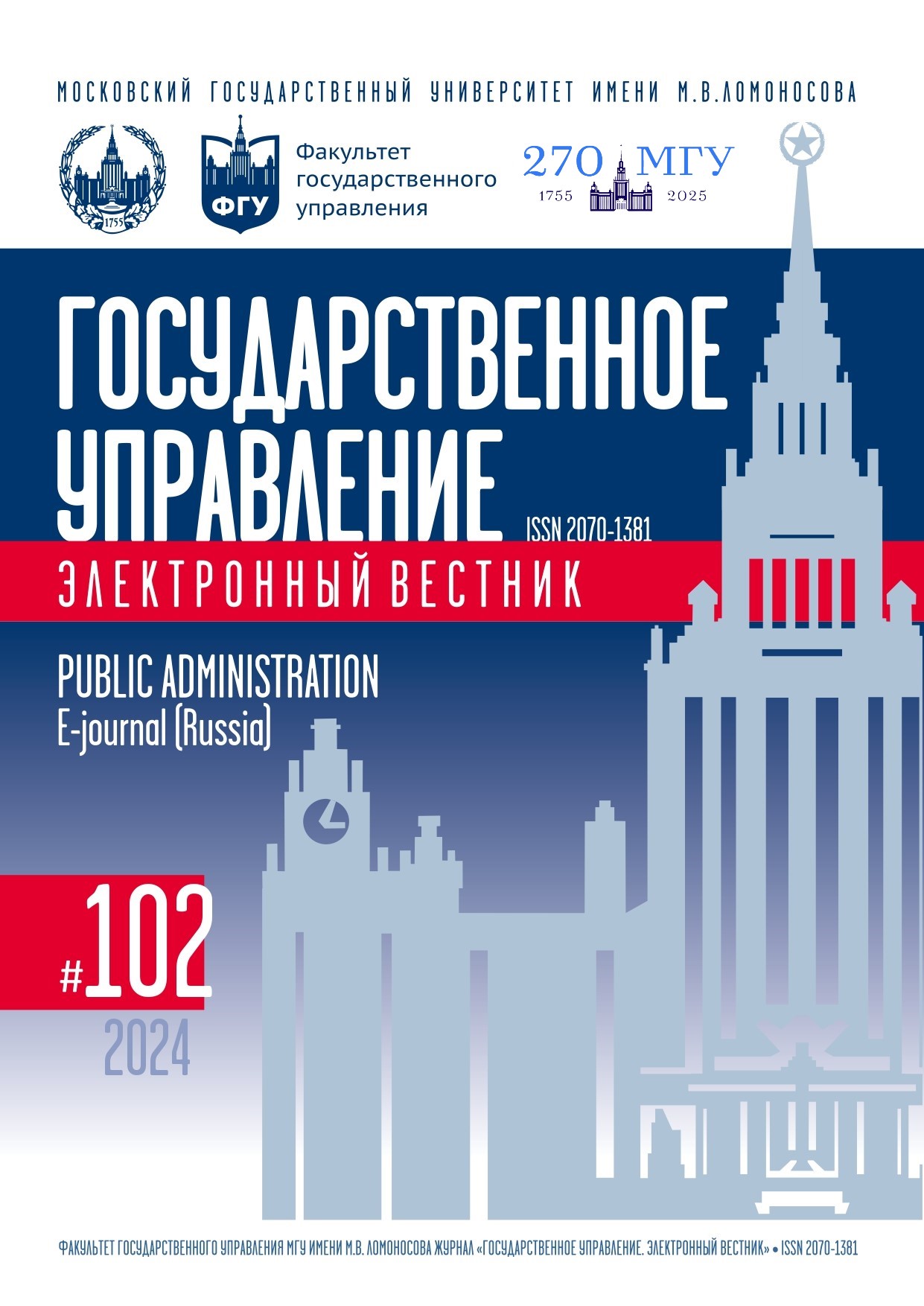Motives for Entering Public Services as Factors of Organizational Citizenship Behavior
DOI:
https://doi.org/10.24412/16nhc813Keywords:
Organizational citizenship behavior, extra-role behavior, motivation of public servants, prosocial motivation, behavior of public servants.Abstract
The aim of this article is to identify the relationship between motivation of public servants and organizational citizenship behavior. The motives for working at public service are: prosocial motives (desire to help society), motives for serving the state (a desire to influence important decisions for the development of the state), prestige motives and social stability motives (stability of work, wages, social guarantees). Various forms of organizational citizenship behavior of public servants have been studied (showing initiative, providing moral support to colleagues, exchanging professional experience, assistance to departments’ colleagues, state body’s employees and employees of other organizations). The issue which types of motives for working at public service are the most significant for organizational citizenship behavior has been studied. The hypothesis was tested by conducting semi-structured interviews with public servants of one of the federal executive authorities. As a result of the interviews, it was found that all state public servants tend to show organizational citizenship behavior, despite the strict framework established by their labor contracts. Public servants with prosocial motivation show all the identified forms of organizational citizenship behavior. At the same time, public servants with other motives for working at public service (serving the state, prestige, stability), tend to show organizational citizenship behavior only in certain forms (showing initiative, providing moral support to colleagues, sharing professional experience, assistance to departments’ colleagues). As a result of this research, it is concluded that prosocial motivation for working at public service is a predictor of organizational citizenship behavior.
References
Алексеева Е.А. Концепт организационной приверженности в социологической дискуссии // Казанский социально-гуманитарный вестник. 2022. № 6(57). С. 4–10. DOI: 10.26907/2079-5912.2022.6.4-10
Вебер М. Хозяйство и общество: очерки понимающей социологии в 4-х томах. Том 1. Социология. М.: Изд. дом Высшей школы экономики, 2016.
Емельянова О.Я., Шершень И.В., Кравец М.А. Исследование мотивационных факторов в профессиональной адаптации государственных гражданских служащих // Регион: системы, экономика, управление. 2020. № 4(51). С. 86–92. DOI: 10.22394/1997-4469-2020-51-4-86-92
Овчаренко Р.К., Лунева И.А., Штепа М.А. Мотивация гражданских служащих и результативность их профессиональной служебной деятельности (по данным социологического опроса) // Государственное и муниципальное управление. Ученые записки. 2020. № 1. С. 50–54. DOI: 10.22394/2079-1690-2020-1-1-50-54
Родюкова Т.Н. Проблемы мотивации и стимулирования на государственной гражданской службе // Гуманитарные, социально-экономические и общественные науки. 2023. № 2. С. 46–50. DOI: 10.23672/SAE.2023.17.65.001
Сидоренков А.В., Бороховский Е.Ф. Гражданское поведение и организационная коммуникативность работников в институциональном контексте // Journal of Institutional Studies. 2020. № 2. С. 119–131. DOI: 10.17835/2076-6297.2020.12.2.119-131
Сидоренков А.В., Штроо В.А., Бороховский Е.Ф. Связь идентификаций и организационного гражданского поведения научно-педагогических работников в вузе // Психология. Журнал Высшей школы экономики. 2022. № 2. С. 323–337. DOI: 10.17323/1813-8918-2022-2-323-337
Aqli Z., Ujianto, Syafi’I A. Public Employees’ Risk Aversion and Organizational Citizenship Behavior: The Effects of Ethical Leadership, Work Culture and Public Service Motivation // Public Administration Issues. 2019. Vol. 6. DOI: 10.17323/1999-5431-2018-0-5-145-162
Bright L. Why Do Public Employees Desire Intrinsic Non-Monetary Workplace Opportunities? // Public Personnel Management. 2009. Vol. 38. Is. 3. P. 15–37. DOI: 10.1177/009102600903800302
Grant A., Mayer D. Good Soldiers and Good Actors: Prosocial and Impression Management Motives as Interactive Predictors of Affiliative Citizenship Behaviors // Journal of Applied Psychology. 2009. Vol. 94. Is. 4. P. 900–912. DOI: 10.1037/a0013770
Kim S. Public Service Motivation and Organizational Citizenship Behavior in Korea // International Journal of Manpower. 2006. Vol. 27. Is. 8. P. 722–740. DOI: 10.1108/01437720610713521
Organ D.W. Organizational Citizenship Behavior: The Good Soldier Syndrome. Lexington, MA: Lexington Books, 1998.
Perry J.L., Wise L.R. The Motivational Bases of Public Service // Public Administration Review. 1990. Vol. 50. Is. 3. P. 367–373. DOI: 10.2307/976618
Rioux S., Penner L. The Causes of Organizational Citizenship Behavior: A Motivational Analysis // Journal of Applied Psychology. 2001. Vol. 86. Is. 6. P. 1306–1314. DOI: 10.1037/0021-9010.86.6.1306
Scott P.G., Pandey S.K. Red Tape and Public Service Motivation: Findings from a National Survey of Managers in State Health and Human Services Agencies // Review of Public Personnel Administration. 2005. Vol. 25. Is. 2. P. 155–180. DOI: 10.1177/0734371X04271526
Yudiatmaja W.E. How Does Public Service Motivation Contribute to Service Orientation? Testing Mediation Models // Otoritas: Jurnal Ilmu Pemerintahan. 2019. Vol. 9. Is. 2. P. 162–178.
Downloads
Published
Similar Articles
- Elena V. Selezneva, Gulzat A. Kenesova, Values of Civil Servants in the Republic of Kazakhstan in Their Representations , Public Administration. E-journal (Russia): No. 90 (2022)
- Aleksandra A. Sidorova, University as an Ambidextrous Organization , Public Administration. E-journal (Russia): No. 108 (2025)
- Tatiana V. Zaytseva, Anna A. Suvorova, The Organizational Support That Encourages Employees-Applicants of Research Organizations to Defend Scientific Papers , Public Administration. E-journal (Russia): No. 99 (2023)
- Elena V. Selezneva, The Value of Public Service in Representations of Russian Civil Servants , Public Administration. E-journal (Russia): No. 96 (2023)
- Igor S. Kalganov, Features of Innovation Processes in Public Administration Sector in Conditions of Digital Transformation of Russian Economy , Public Administration. E-journal (Russia): No. 102 (2024)
- Valery N. Minat, Ethnocultural Polarization of Government Personnel and the Choice of Public Administration Model (Using the Example of the Southwestern United States) , Public Administration. E-journal (Russia): No. 102 (2024)
- Pavel A. Tikhomirov, Nadyezhda V. Makogonova, Fixed-Price Bidding as a Prospective Anti-Corruption Mechanism for Competitive Order Placement in Public Procurement in the Russian Federation , Public Administration. E-journal (Russia): No. 108 (2025)
- Valeria Yu. Dmitrievskaya, Tatiana V. Zaitseva, Social Embeddedness of Material Motivation in Organizational Workforce , Public Administration. E-journal (Russia): No. 111 (2025)
- Sergey N. Grinyaev, Value Orientations and Public Service in the Context of New Challenges and Threats , Public Administration. E-journal (Russia): No. 108 (2025)
- Aleksandra A. Sidorova, Организационная амбидекстрия: концептуальные основы и современные подходы , Public Administration. E-journal (Russia): No. 98 (2023)
You may also start an advanced similarity search for this article.




